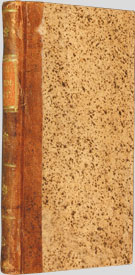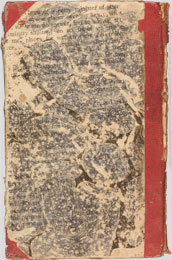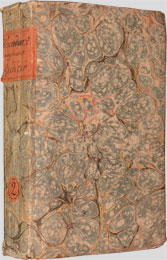Marbled paper
One of the most common methods of decorating the endpapers
of hand-bound books is marbling. Although collectors and others who are
used to handling and viewing books of the past often take little notice,
to those who haven’t encountered marbled paper before, its splendid
variety of patterns and colors can be an eye-opening experience.
Far from being a recent decorative innovation,
the marbling of paper dates back to at least 1118 a.d. and a Japanese publication
whose title translates as Poetical Works of the Thirty-six Men.
The paper was produced by a method known in Japan as suminigashi,
or “a pattern formed by floating ink,” which aptly and concisely
describes the nature of the process. Marbled paper is created by floating
colors on the surface of water, working the colors into patterns, and then
transferring the pigments onto a sheet of paper. Books covered with these
geometric and random patterns of color can be quite striking.
Marbled paper was in use in the Near East in the
succeeding centuries after its documented appearance in Japan, though it’s
not known whether it developed independently or if it migrated westward
from Japan or China. European travelers must have seen marbled paper when
they visited Persia and Turkey in the sixteenth century, and by the early
seventeenth-century, similar paper was being produced in Germany. The craft
of paper marbling spread quickly to France, and eventually to the rest of
Europe. John Evelyn demonstrated marbling to the Royal Society in 1662.
Before marbling became an established trade in England in the late eighteenth
century, marbled sheets imported from the Continent proved very popular
among bookbinders, who used them frequently for endpapers and the coverings
of bindings. Marbling arrived in the United States in the early nineteenth
century.
In addition to blank paper, artisans also marbled
surplus or waste sheets, and it is this practice of recycling that created
some of the marbled sheets most prized by Americana collectors. Sometime
after 1800, a still-unidentified printer in New England undertook an edition
of John Cleland’s notorious Memoirs of a Woman of Pleasure (known
colloquially as Fanny Hill, after its main character). The title-page
falsely identified it as having been produced in “London: Printed
for G. Felton, in the Strand, 1787.” For reasons that are still the
subject of speculation, the printer abandoned the edition, apparently after
completing the first part of the book. The printed sheets were marbled (“overmarbled”
is the technical term) and used to cover the plain board
bindings of books of all kinds. Over the years, the marbling has worn away,
revealing—on a variety of much more innocent books, ranging from textbooks
to religious works—portions of the beginning of the story of Fanny
Hill. A number of these books survive, and they appear on the market from
time to time, where they are acquired far less for their texts than for
what is revealed beneath the marbling.
While marbled paper was widely used on books well
into the nineteenth century, its popularity slowed after the mechanization
of new-book binding. Marbling never died out completely, however, and it
remains popular today both for custom bookbinding and as a craft practiced
by people of all ages.
Paper marbling seems magical, and yet it is improbably
simple. The basics haven’t changed very much over the past several
hundred years. It still involves depositing bits of color on the surface
of water (to which a thickening agent has been added) and arranging those
colors, through the use of combs or other implements, into patterns that
are then transferred to a sheet of paper. It is fairly simple to follow
a manual and produce a sheet of marbled paper, just as one can also follow
instructions and produce a sound by drawing a bow across the strings of
a violin. In each case, one will get results, but the results may not be
pleasing. With marbling, it takes practice to learn the proper amount of
thickening agent to add to the water so that the colors will float and some
experimentation to create pleasing patterns. Placing and removing the paper
to be marbled from the surface of the water also requires delicacy. With
diligence and experience, the results do improve, and paper marbling can
become an addictive hobby.
Many marbled papers used for endpapers and bookbinding
have similar designs. Applying the colors to the water’s surface in
a set manner and manipulating them with specific combs, as described in
marbling manuals, create standard patterns. While the sheets will exhibit
some variation, an experienced practitioner can create very similar and
consistent designs.
Not all of the decorated paper found in books is “marbled.” Some
designs are produced using woodblocks or engraved plates, while others have
patterns created by a process involving colored paste. These “paste
papers,” as they are known, are also quite common on book bindings.
Further Reading
 The
standard history of the field, which was of great help in the writing of
this article, is Richard Wolfe’s Marbled Paper: Its History,
Techniques, and Patterns (Philadelphia: University of Pennsylvania
Press, 1990). Wolfe covers both Eastern and Western marbling, with particular
emphasis on marbling in Britain and America. His detailed notes are essential
for anyone doing research in the field. A more general account of several
types of decorated paper is Rosamond B. Loring’s Decorated Book
Papers: Being an Account of their Designs and Fashions (Cambridge:
Harvard College Library, 1942). Later editions, edited by Philip Hofer,
contain additional essays about Loring’s life and work. They do not,
however, include original samples of marbled and decorated papers included
in the 250-copy first edition. No list, however brief, of reading about
marbled paper should exclude mention of some of the many works on the subject
published by the Bird & Bull Press of Henry Morris: The Mysterious
Marbler (1976); Karli Frigge’s Life in Marbling (2004);
and The World’s Worst Marbled Papers (1978), complete with
paper samples.
The
standard history of the field, which was of great help in the writing of
this article, is Richard Wolfe’s Marbled Paper: Its History,
Techniques, and Patterns (Philadelphia: University of Pennsylvania
Press, 1990). Wolfe covers both Eastern and Western marbling, with particular
emphasis on marbling in Britain and America. His detailed notes are essential
for anyone doing research in the field. A more general account of several
types of decorated paper is Rosamond B. Loring’s Decorated Book
Papers: Being an Account of their Designs and Fashions (Cambridge:
Harvard College Library, 1942). Later editions, edited by Philip Hofer,
contain additional essays about Loring’s life and work. They do not,
however, include original samples of marbled and decorated papers included
in the 250-copy first edition. No list, however brief, of reading about
marbled paper should exclude mention of some of the many works on the subject
published by the Bird & Bull Press of Henry Morris: The Mysterious
Marbler (1976); Karli Frigge’s Life in Marbling (2004);
and The World’s Worst Marbled Papers (1978), complete with
paper samples. 




